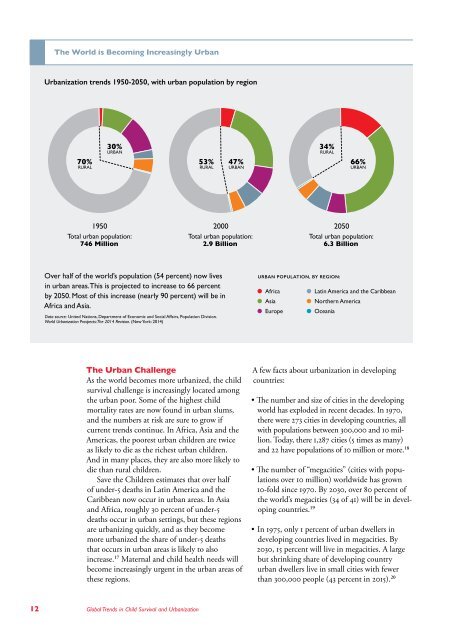sowm_2015__int__africa_full_report_low_res
sowm_2015__int__africa_full_report_low_res
sowm_2015__int__africa_full_report_low_res
Create successful ePaper yourself
Turn your PDF publications into a flip-book with our unique Google optimized e-Paper software.
The World is Becoming Increasingly Urban<br />
Urbanization trends 1950-2050, with urban population by region<br />
70%<br />
RURAL<br />
30%<br />
URBAN<br />
53%<br />
RURAL<br />
47%<br />
URBAN<br />
34%<br />
RURAL<br />
66%<br />
URBAN<br />
1950<br />
Total urban population:<br />
746 Million<br />
2000<br />
Total urban population:<br />
2.9 Billion<br />
2050<br />
Total urban population:<br />
6.3 Billion<br />
Over half of the world’s population (54 percent) now lives<br />
in urban areas. This is projected to increase to 66 percent<br />
by 2050. Most of this increase (nearly 90 percent) will be in<br />
Africa and Asia.<br />
Data source: United Nations, Department of Economic and Social Affairs, Population Division.<br />
World Urbanization Prospects: The 2014 Revision. (New York: 2014)<br />
URBAN POPULATION, BY REGION:<br />
● Africa ● Latin America and the Caribbean<br />
● Asia<br />
● Northern America<br />
● Europe ● Oceania<br />
The Urban Challenge<br />
As the world becomes more urbanized, the child<br />
survival challenge is increasingly located among<br />
the urban poor. Some of the highest child<br />
mortality rates are now found in urban slums,<br />
and the numbers at risk are sure to grow if<br />
current trends continue. In Africa, Asia and the<br />
Americas, the poo<strong>res</strong>t urban children are twice<br />
as likely to die as the richest urban children.<br />
And in many places, they are also more likely to<br />
die than rural children.<br />
Save the Children estimates that over half<br />
of under-5 deaths in Latin America and the<br />
Caribbean now occur in urban areas. In Asia<br />
and Africa, roughly 30 percent of under-5<br />
deaths occur in urban settings, but these regions<br />
are urbanizing quickly, and as they become<br />
more urbanized the share of under-5 deaths<br />
that occurs in urban areas is likely to also<br />
increase. 17 Maternal and child health needs will<br />
become increasingly urgent in the urban areas of<br />
these regions.<br />
A few facts about urbanization in developing<br />
countries:<br />
• The number and size of cities in the developing<br />
world has exploded in recent decades. In 1970,<br />
there were 273 cities in developing countries, all<br />
with populations between 300,000 and 10 million.<br />
Today, there 1,287 cities (5 times as many)<br />
and 22 have populations of 10 million or more. 18<br />
• The number of “megacities” (cities with populations<br />
over 10 million) worldwide has grown<br />
10-fold since 1970. By 2030, over 80 percent of<br />
the world’s megacities (34 of 41) will be in developing<br />
countries. 19<br />
• In 1975, only 1 percent of urban dwellers in<br />
developing countries lived in megacities. By<br />
2030, 15 percent will live in megacities. A large<br />
but shrinking share of developing country<br />
urban dwellers live in small cities with fewer<br />
than 300,000 people (43 percent in <strong>2015</strong>). 20<br />
12 Global Trends in Child Survival and Urbanization




